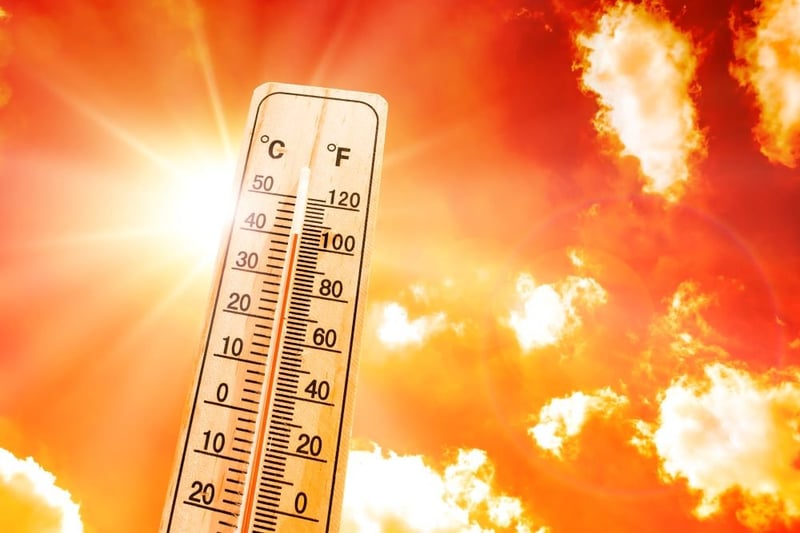Get Healthy!

- Cara Murez
- Posted October 10, 2023
Runaway Global Warming Will Make Some Areas Too Hot for Human Life
The signs of climate change are everywhere, from raging wildfires to flash flooding to soaring temperatures.
Now, a new study warns that things could get worse, with scientists reporting that even small increases in global temperatures will make some parts of the Earth too hot for humans to endure.
"As long as we continue to put greenhouse gases emissions into the atmosphere, we're going to continue warming,"said study author Daniel Vecellio, a postdoctoral research scholar at the George Mason University's Virginia Climate Center.
"The take-home message is that we want to keep global warming to as much of a minimum as we can,"said Vecellio, who conducted the research while at Penn State University. "The easiest thing to say, but I guess as we see the hardest thing to do is to accelerate our reductions in greenhouse gas emissions as quickly as possible in order to stave off these worst effects."
In the study, scientists used lab-measured, physiologically-based temperature thresholds at a range of air temperatures and relative humidity.
The team modeled global temperature increases ranging from 1.5 degrees Celsius (C) to 4 degrees C (2.7 degrees F to 7.2 degrees F) above what temperatures were when the industrial revolution began. The Paris Agreement, signed by 196 nations from around the world in 2015, aims to limit those increases to 1.5 C.
The threshold for what can be endured needs to factor in such variables as humidity, wind speed, solar radiation and a person's exertion level at the time.
Earlier research by the same Penn State team offered new evidence showing the human body could only tolerate lower limits than what had been believed. And older adults experience these consequences at even lower heat and humidity levels.
This new study shows that if global temperatures grow by 2 degrees C, areas in Pakistan, India's Indus River Valley, eastern China and sub-Saharan Africa will have many hours of heat exceeding what humans can stand every year, affecting about 4 billion people. These areas are also home to lower-to-middle income nations, where many people may have no access to air conditioning during heat waves.
At an increase to 3 degrees C, parts of the United States would also be affected, including the Midwest and the Eastern Seaboard. Also affected would be South America and Australia.
Simply crossing this threshold does not make a place too hot for humans, Vecellio noted.
"It depends on the duration of these things as well,"Vecellio added.
In the absence of measures like getting into the shade and drinking water, it would take about six or seven hours of continuous exposure for someone to reach core temperatures that are associated with heat stroke, Vecellio said.
"If that six hours is done over six days, for one hour a day, that does not make Chicago unlivable,"Vecellio explained.
What it might mean is changing behaviors with an eye toward safety.
"We shouldn't rely on the results from this paper "¦ to start coming up with adaptation and mitigation strategies and how to build better resilience in our public health facilities and things of that sort, to make sure that we're keeping people safe in the heat,"Vecellio said. "Way before we get to these thresholds that we talk about in our paper, people are already dying and falling ill to the heat in the United States and across the world."
Experts have said the world probably will be 3 degrees C warmer by 2100, Vecellio said.
Vecellio noted that Americans are sometimes unaware of what's happening with climate change in other parts of the worlds.
Those who will be hit the soonest and hardest are those who had little to do with creating the climate issues.
"I hope that it brings to mind what we're doing here has impacts all across the world. It's the ones that are most vulnerable that are going to suffer the most,"Vecellio said.
The findings were published online Oct. 9 in the Proceedings of the National Academy of Sciences.
Rachel Licker, a principal climate scientist for the Union of Concerned Scientists, said the research "underscores the urgency for society to get off of fossil fuels as quickly as possible."
Licker called for putting as much pressure as possible on policymakers to reduce heat-trapping emissions quickly and enact policy measures to get there.
That would include using electricity instead of fossil fuels and powering the grid system with renewable resources.
"We have really an outsized responsibility to lead the way with respect to climate action,"Licker said, referring to the United States. "We need to be making sure that we're investing in the clean energy transition as quickly as possible."
People can think about this when they vote, Licker suggested, electing policymakers who are following the science.
While individuals can do their part, large corporations emit a high percentage of greenhouse gases, Vecellio said. It's up to leaders around the world to reduce greenhouse gas emissions quickly, adopt more renewable energy and tamp down the warming, he said.
More information
NASA has more on climate change.
SOURCES: Daniel Vecellio, PhD, postdoctoral research scholar, Virginia Climate Center, George Mason University, Fairfax, Va.; Rachel Licker, PhD, principal climate scientist, Union of Concerned Scientists, Madison, Wisc.; Proceedings of the National Academy of Sciences, Oct. 9, 2023, online




